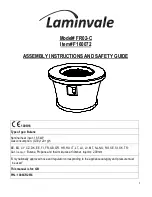
INSTRUCTIONS FOR THE INSTALLER
11
2.
Figure No.12 -
Insert frame in the
appliance
2.4.
Chimney flue
The chimney flue must comply with
present standards on the installation of
chimneys.
In rooms equipped with Controlled
Mechanical Ventilation, the ventilation
outlet must never be connected to the
flue.
The appliance must always have its own
chimney flue, never sharing a chimney flue
with another appliance.
2.4.1.
Type of flue
The flue must be made of special
material designed to resist the products of
combustion (e.g. stainless steel, enamelled
steel, etc.).
Non-central-heating
appliances
(without back boiler) require an insulated,
double-sleeve flue only on those sections
that run outdoors or through cold areas.
Single piping can be used inside the
building, the heat of the gases serving to
heat rooms, insulating only those sections
where excess temperature may cause
damage.
If the chimney is constructed, then it is
necessary to pipe and insulate it to ensure
correct updraught.
The diameter of the pipe must be the
same as the diameter of the flue socket on
the appliance over its entire length in order
to ensure correct operation.
The flue must prevent the entry of
rainwater.
The flue must be clean and airtight over
its entire length.
The flue must be at least 5m tall and the
chimney cap must not hinder the free
release of gases.
If the flue tends to suffer from
downdraught, then it is necessary to fit an
effective anti-downdraught cowl, a static
cowl or a smoke extraction fan, or reshape
the chimney.
Never make 90º bends, due to the great
loss of draught they cause, and reduce 45º
bends down to an absolute minimum. Each
45º bend is equivalent to a 0.5m reduction
in flue length. Horizontal flue sections
should not be installed because they cut
updraught a great deal.
The appliance is designed to operate
under controlled draught conditions. The
appliance must operate at a chimney
draght of between 12Pa and 15Pa. To
ensure this draught, an automatic draught
moderator must be installed in the flue.
Uncontrolled draught operation can lead to
quick damage of the appliance, which will
not be covered by the warranty.
The flue must not rest its weight on the
appliance, as this could damage the
worktop.
Bear in mind that high temperatures
may be reached in the flue, meaning that it
is essential that insulation be enhanced in
sections in which combustible material is
present (wooden beams, furniture, etc.). It
may even be necessary to protect non-
combustible material in order to prevent
breakage, deformation, etc., as a result of
overheating if the material is not designed
to withstand high temperatures.
Содержание Nickel AUSTRALIA
Страница 1: ...Nickel Instruction Book AUSTRALIA ...
Страница 6: ...PRESENTATION OF THE APPLIANCE 5 1 Figure No 2 Dimensions of the Nickel 1000 appliance in mm ...
Страница 23: ...BASIC BREAKDOWNS 22 6 5045300005 Cjto marco de 50 Silver 1000 For Nickel 1000 South Africa and Australia 2 ...
Страница 24: ...CERTIFICATE OF COMPLIANCE 23 7 CERTIFICATE OF COMPLIANCE ...
Страница 25: ...CERTIFICATE OF COMPLIANCE 24 7 ...
Страница 26: ......
Страница 27: ......
Страница 28: ......













































